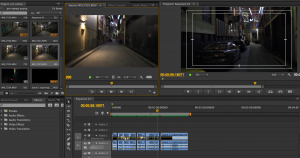Brief 4 Final
Final sequences:
Finally, it is week 12 and every single assignment that has been haunting us is all finished. My Popular Cinema essay, Creative Advertising “post-card” campaign and now the On The Frame brief 4 exegesis and the test sequences are all over. The last blog update was about the process of this brief 4 project up to the point where Dyy and I just finished shooting. So here are some progress made since then on.
The editing process, which took a while longer as a result of technical (Premiere Pro) incompetence. At first we thought that we could include some background music and sound effects, though we changed our mind to stick with the natural background sounds recorded diegetically. This is because I think it works better in focusing dominantly on the frame’s aesthetics and movement rather than some music added in. While I was editing the opening scene, I found that it was quite hard to have the sequences matching up with the storyboard that I have sketched. Therefore while trying to follow my storyboard, I have also done some experiment on cuts and matching shots and have learned a whole lot more in how to overcome problems in Premiere Pro (mainly through You-Tube and Linda.com). There were shots that needed to be cut and put together. Though as the shot images “rule of thirds” do not match that it obviously show an unwanted cut between those shots, I have learned to use fast-forwarding the duration of the two shots while adding an “additive cross dissolve” video transition effects to make the two shots seems as one.
Focusing greatly on both the opening scene and the ending scene, we decided to only edit and submit these sequences as tests or experiments without having the whole film drawn in the storyboard fully finished. Throughout my exegesis, I am also able to answer the research question that if “the camera is an extension of human body, can then film think and develop just as human being do?” This is an interesting notion that film is able to, as it is a mirror to human mind therefore can think. Futhermore, film can stretch its ideas as a result of the possibility that it is a form of future thinking, hence develop its thoughts just as human being learns new knowledge.








